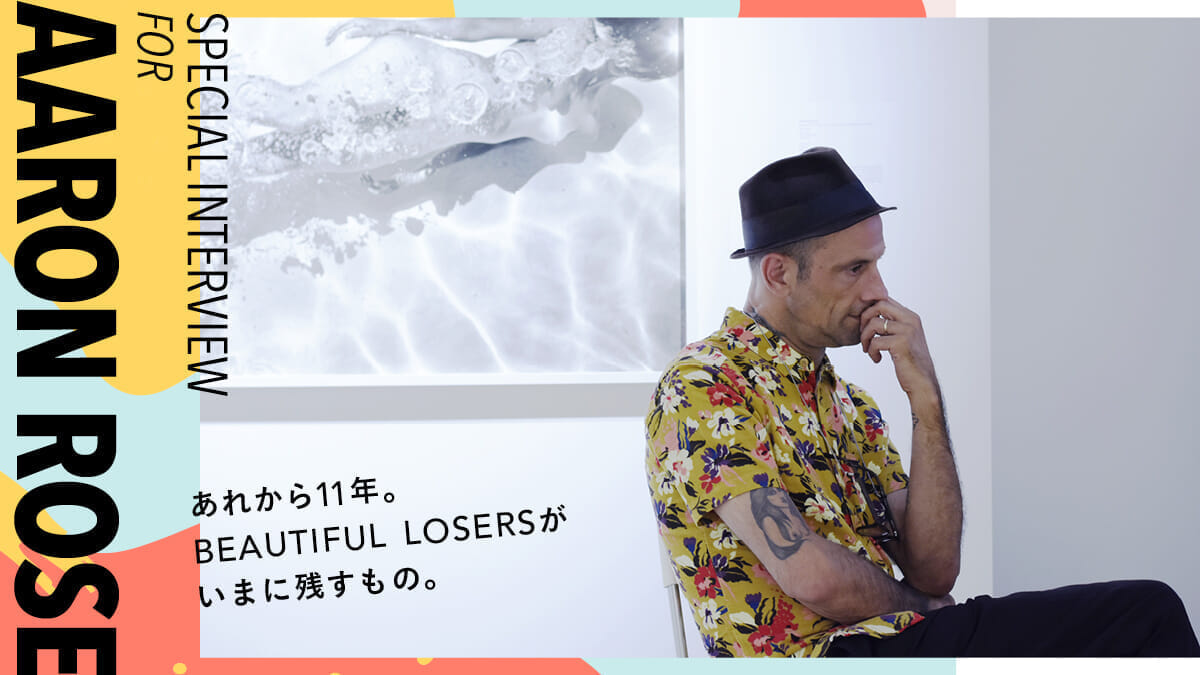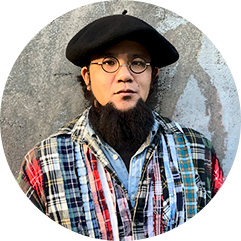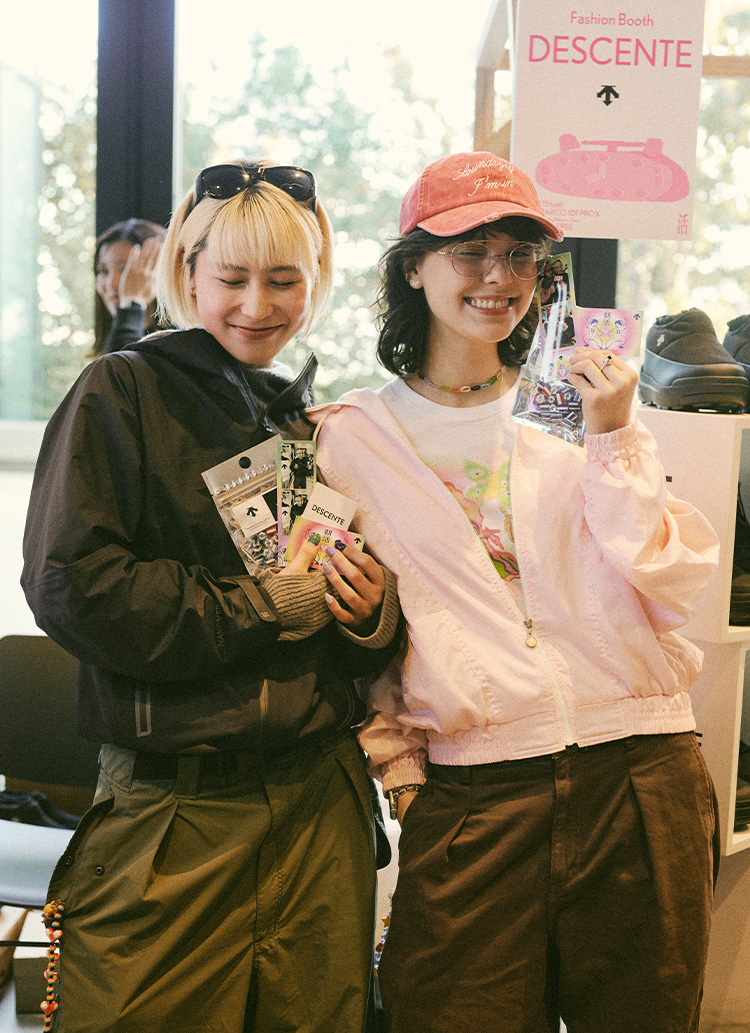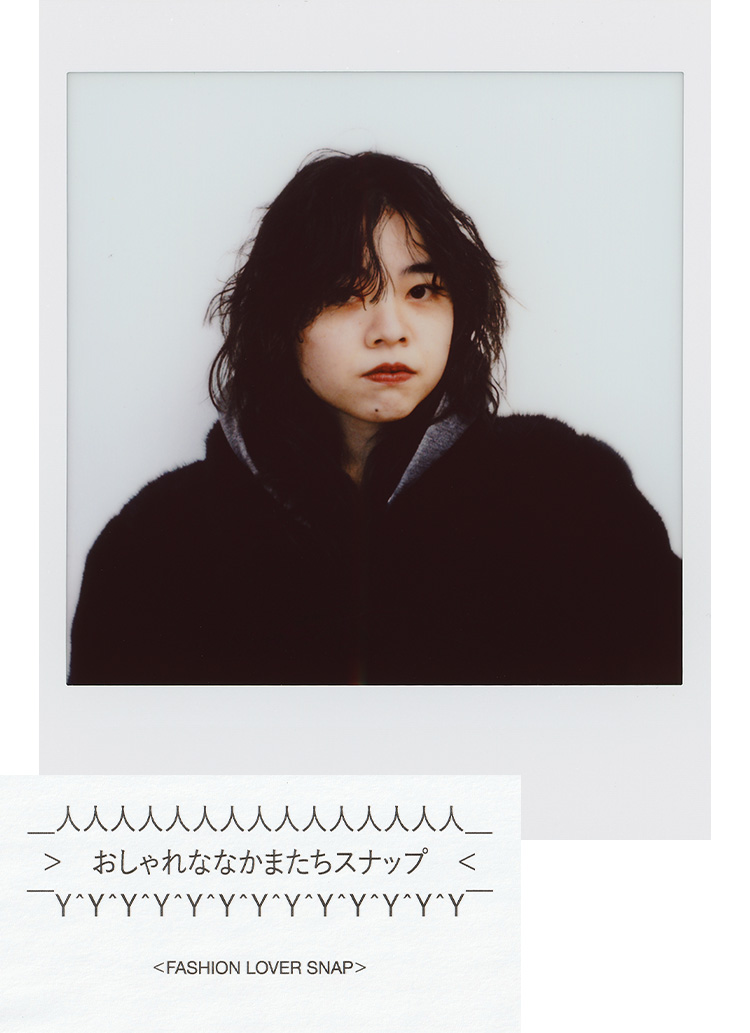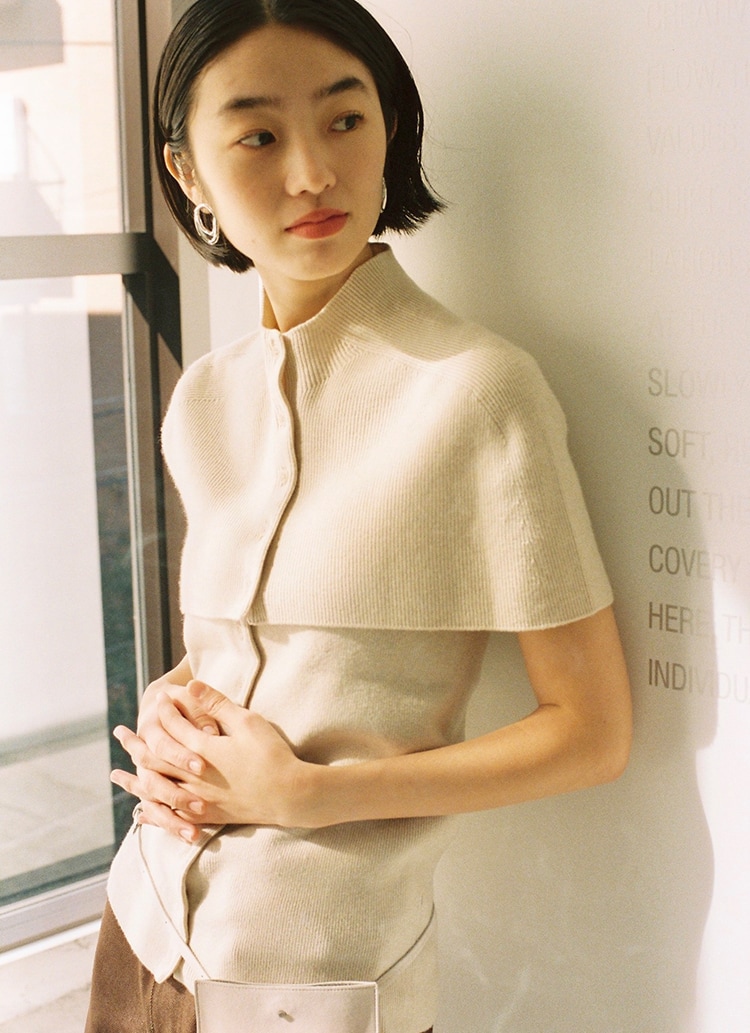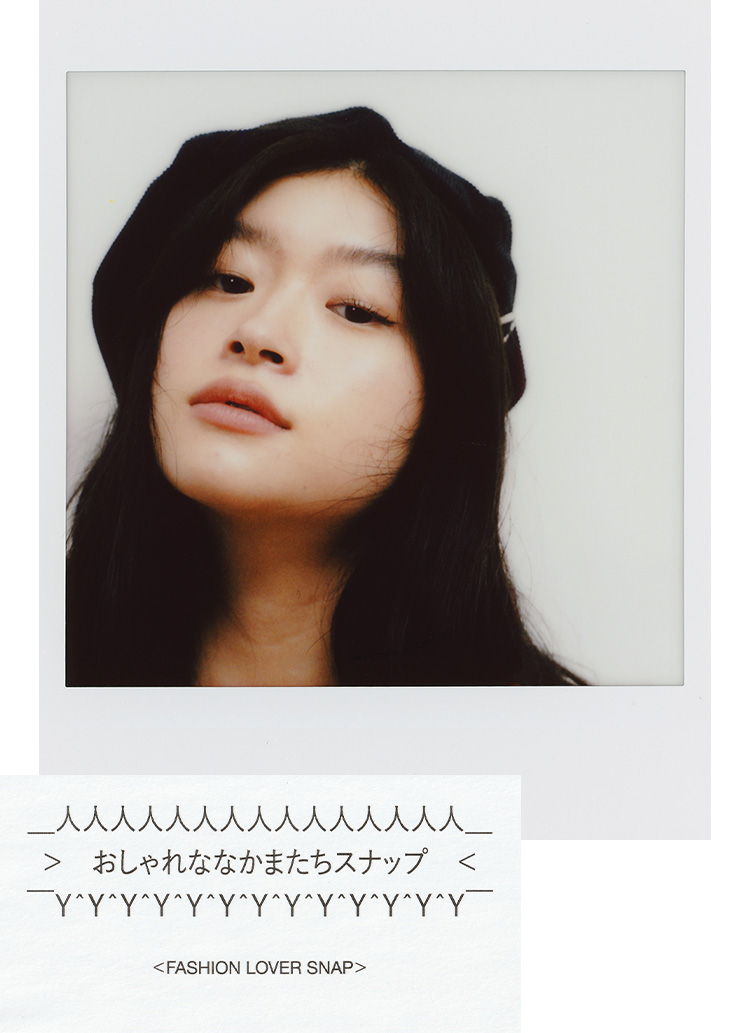Art was prestigious and only for the educated. It was important for us to do it with our friends, because such a common sense was deeply rooted in those days.

First of all, I would like to look back on Aaron's own career.
- First of all, please tell us about your career also the reason why you're interested in Art.
I'm not exactly sure what exactly sparked his interest in art, but it seems that when he was 4 or 5 years old, he was building cities with Legos that we had at home and drawing doodles on notepads. It was nothing special, just something that any kid around that age would do. I think that was my first encounter with art. I remember my parents taking me to galleries and museums several times, but I don't think I was bored or had any particular perspective on art. Not long after that, I started skateboarding. The place was Washington Square Park, where the movie "Kids" is set. I had a great encounter there.
I don't actually remember but I started drawing and making art like Lego when I was like 4 or 5 years old. But maybe that was the first time art impacted my life. My parents took me to Galleries and Museums a few times but I don't really think about art at that time. Then I started skateboarding right after at the skateboarding park called Washington Square Park That is a big thing for me.
What kind of people gathered at that place at that time?
- Who were hanging out at the Washington square park?
The people in the movie "Kids" as well as the artists who were involved in the "Arranged Gallery". At that time, the skater community was small and closed. If you went there, you had someone to hang out with, and even if you didn't know anyone, if you were someone's friend, you could easily become friends with them. It was a place with a special atmosphere that is unimaginable nowadays. And one day, while skateboarding, I found myself looking down on the daily life of my friends.
People from KIDS for sure, also artists involved in Alleged Gallery. the skateboard community was so small and closed at that time. I got a wider perspective.
Did you decide to start "Arranged Gallery" at that time?
- So that made you open Alleged gallery?
At that time, music was more important to us than art. We were looking for a place where we could all enjoy the music to the fullest, so we rented a small vacant house on the Lower East Side, where the market value was not as high as it is now. There was a bar next door called Max Fish, and it was an area where a lot of street people were congregating. So at first it was just two DJs and me living there and doing music events for our own people. We didn't even have a name "Arranged Gallery" at that time. Some of my friends started drawing graffiti on the walls and hanging their own artwork without my permission. Then, strangely enough, there were a lot of people who wanted to have and see more of that kind of art. At first I thought, "Are you kidding? I thought, "No way. Because the people who painted those works were all unknown amateurs who didn't even understand what art was about.
The music scene was more important than Art for us at that time. We all were looking for a place where we could enjoy music so we rented a small house in the Lower east side since it was much cheaper than now. The bar called Max Fish was next to our house. That was the area where all the people from street scene gathered. My two friends who both are DJs and I were living there and just having little music events. It wasn't even called Alleged galley at that time. Loads of people started hanging out at the house and they started drawing graffiti and putting up their art. People started saying that they wanted to see more art. I was like "Why?". It was made by unknown artists who don't even understand what art is.
You named it "Alleged Gallery" (a place like a gallery) because it was not intended to be a gallery in the beginning. And now, many artists of international renown have gathered there.
- You named it Alleged gallery. And so many artists became big now from there.
As it turns out. In the beginning, we were all just friends. There were a lot of skaters I met in Los Angeles before I came to New York. Art was prestigious and only for the educated. It was important for us to do things with our friends, as if we were speaking out against such a common sense that was so strongly rooted in the times. And our friends at the time were all full of energy for creation and expression.
A result, yes. But we were just friends back then. Also there were some skaters who I met in LA before I came to NY. That's what everyone thought, so it was really important to do it with my friends. And everyone was so passionate making art and showing their expressions.
What was the atmosphere of street art, skate scene, and youth culture in New York at that time? It seemed to be a chaotic time that was different from today.
- How do you explain the vibe in the youth street/skateboarding scene at that time compared to now?
It was a time when there was no such thing as street art. And because skateboarding and graffiti were completely illegal at the time, there was a community aspect for young people who grew up in poor environments and were bullied. At the same time, hip-hop music was at its peak, so these ties naturally stirred their desire to express themselves, and they became rebellious, wanting to change the status quo by their own power, and it seems that cultures with such backgrounds were drawn closer together. It was certainly a chaotic time. I think that is why this particular era and the "Arranged Gallery," which I presided over, were able to create an accidental chemical change. But I think it was the highly sensitive people in Japan who hooked me up with the artists and skaters around me that gave me the opportunity to do so. It was only then that we realized our value.
First, During that time there wasn't such a thing as Street Art. Music especially Hiphop was getting so big and it made everyone express themselves more and to feel that they want to change the situation. That's why Alleged gallery got such a great reaction. People with some good taste in Japan were People with some good taste in Japan were hooking us up and made us realize our true values.
Many of my fellow artists have climbed the ladder to success. As I watched them, I felt happy and a little sad.

What were the main exhibitions at the "Arranged Gallery" at that time?
- What was the main exhibition at the gallery?
In the beginning, we exhibited once every three months, and then once a month after that. Anyway, if we had friends who wanted to exhibit there, we would set up an opportunity to display their works, and then we would invite our friends over for a party. It was a new experience for us because we had never had a place where we could express our art before.
We did an exhibition every 3 months at the beginning and then once a month after that. And we kept partying there. There wasn't anywhere better for us.
In 2001, "Arranged Gallery" was regrettably closed. What was the reason?
- Sadly the Gallery was closed in 2001.
The first location where I opened "Arranged Gallery" had a rent of $400, and the next location I moved to had three times the rent of the previous one. I think the main reason for this is the rising cost of rent in the New York area as a whole. Also, during the time that "Arranged Gallery" was there, many of my fellow artists climbed the ladder to success. As I watched, I felt happy and a little sad. I felt that my role was over. Of course, I could have continued to do new things on a regular basis with everyone who was becoming famous, but I felt that I would never be as passionate about it as I had been in the past. So I realized that now was the time to close.
The rent was only $400 at the beginning, but it kept getting more expensive. It was triple the price by the time we moved. It was bittersweet seeing them leave the gallery but also getting successful. I felt that I wasn't as passionate like I was before.
I see. Does that mean that your awareness of art as a business was a negative idea at that time?
- I see. You didn't completely agree with art getting into business at that time.
That was one of the reasons I was disappointed for a while. But I soon became motivated to create something new. I was asked to direct all kinds of advertising projects, including design commissions and curating exhibitions for clients such as Nike from Wieden and Kennedy, which had been an outgrowth of the advertising industry. Then I started doing a little bit more entertainment and commercial film work. At the same time, I started editing zines, photo books, and magazines. Thanks to the friends I made at Arranged Gallery and the great influence of the place, I was able to expand my creative horizons at once.
Yes. But I got motivated again when i started working with likes of NIKE or Wieden+Kennedy. Around 2005 I started making zines and books.

In 2008, the Beautiful Loosers exhibition was held. What made you decide to hold this exhibition, which was a long-awaited project for your friends and fans at Arranged Gallery?
- So in 2008 you had an exhibition called "Beautiful Losers". What made you do it?
I wanted to capture the time I spent with my friends who were becoming famous, just as it was in the atmosphere of that time. When we grow up, we all lose the perspective of our youth. I also wanted to document the history of "Arranged Gallery," which is where we began. I also wanted to preserve the work that I had created, as my own interests had turned toward editorial and video work. I then approached my friend Joshua Leonard, and we worked together on the project, shooting and editing every day. Of course, we had no budget and almost no professional staff. It was a complete DIY project. I don't know how many hours I spent working part-time. I had a lot of help from Harmony Korine and Sofia Coppola.
It wouldn't be the same if we got older. At that time I was making films and my friend Joshua Lenard made a film with me. There wasn't a budget. Pure DIY. Harmony Collin and Sophia Coppola helped me a lot.
With this work, "Arranged Gallery," Aaron, and the artists involved in "Beautiful Loosers" became known on a global scale, and it seems to have become a major movement. How did you feel about the response to your work at the time?
- After that came out the gallery and people got famous.
The exhibition I held in 2008 actually did not have a surprisingly large following. After that, I held a traveling exhibition, published a collection of the works and patterns from the exhibition, and finally began to feel a bit of a response when the exhibition was screened as a film. Then, in 2010, the film was released on Netflix, and the word spread quickly. Since I had rarely been in the public eye, I was basically known only to my friends and a few other people, but since then I have been approached and asked for autographs in New York and other cities. It was a strange feeling.
It blew up on Netflix though. It was weird when people would walk up and shake my hand or try to get a picture with me. or try to get a picture with me.
The members who were in Washington Square Park and "Arranged Gallery" at that time were much more attractive and shining.

I believe that Aaron was also the one who changed the values of contemporary art that flourished in the 70's and 80's, which was called Pop Art, such as Andy Warhol, Basquiat, Keith Haring, etc. At that time, were you aware that you wanted to change the history and culture of Pop Art?
- You changed pop art like Andy Warhol, Basquiat, and Keith Haring.
I never had a sense of wanting to change anything about myself. At the time, I had no sense of mission to change the value of art or anything like that. I also had very little influence from my predecessors. Andy Warhol is great, of course, and he is a universal art legend. And Keith Haring was one of my friends through a mutual acquaintance, Jeremy Henderson, who introduced me to Basquiat, and we used to hang out and party together. Jeremy Henderson was connected with creators of various genres, and his house was a hangout for everyone. I respected these superstars of the art world who changed the meaning of street art, but I thought it was a little different to do something together with them. To me, the members of Washington Square Park and the Arranged Gallery at that time were much more attractive and shining.
Andy is a legend and Keith was Jeremy's friend. He introduced us and we got together at parties. I respect them a lot but I wanted to go solo. I preferred my friends from the skate park or the gallery.
This is the charm of "Arranged Gallery" and the reason why the artists around him were able to trust Aaron. And Aaron's attitude of supporting artists who have no name is the most important artist-first mindset in the art scene.
- Is that why you support the art scene and young artists?
The most important thing I look for in an artist is originality that only he/she can bring to the table, not some unknown young talent. I don't like to be inspired by something else. It is also important not to be influenced by name value or the reputation of others.
It's not because they're young. I just support originality not rip-offs. I just support originality not rip-offs.
Are there any other words of spirit, attitude, or aphorisms that Aaron values in his continuing curatorial career?
- Is there any spirit or thoughts that you can share as a curator?
The words "FOREVER NOT PROFESIONAL." Keep a fresh mindset by cherishing your initial intentions. Motivation is one of the most important factors in the art world. If you are a doctor, you should be professional, but an artist does not necessarily need to be professional (laughs).
Forever not professional. Keep your mind fresh. Doctors have to be profession, not artists.

Aaron, did you ever want to be an artist yourself?
- Why didn't you want to be an artist instead of a curator?
I have already mentioned that drawing as a child was my original experience of art, and I myself like painting and graphic design. That is why I am showing my work in this exhibition, and I am constantly creating. I am also planning to have a solo exhibition in Italy. You will be able to see my mindset, which is different from this time.
I've been painting since childhood so I like it. i have this exhibition going on now but my next one is in Italy.
That's exciting. By the way, if you had to name one of the most impressive artists you have ever met, who would it be?
- Who is the most impressive artist for you?
If I had to choose one person, I would say Margaret Kilgallen. She was a female graffiti artist who was a minority in the U.S. at the time, when there was not as much interest in LGBTQ and other social issues as there is now. She was not a topic of conversation because she was a woman, but because she had a sensitivity and originality that was more subtle than anyone else's. She had a lot of in-your-face ideas. Her creations inspired me a lot. She passed away from an illness the year Arranged Gallery closed, but even now, when I am troubled or hit a wall, I look up at the sky and remember her face and her words.
There wasn't LGBTQ at that time. She was a minority who was the only female graffiti artist. Unfortunately she died when the gallery was closed. Every time I have a problem I look at the sky to remember Every time I have a problem I look at the sky to remember her face and words.
Aaron, there are a lot of creators besides artists and skaters around you, do you get inspiration from them?
- There are so many creators and skaters around you. Did you get inspired by them too?
Of course. Art, music, fashion, skateboarding, and other cultures are closely interrelated and respectful of each other. And the end result is cinema, which is called a comprehensive art form. Everything is connected. And I have many elements that form that connection from my friends. That is my legacy.
Those cultures are so close so we respect each other. Movies are the best level of art. I really appreciate my friends.


